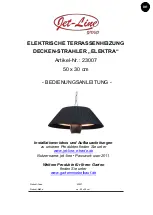
32
LP-179 REV. 11.26.14
Total maximum equivalent length of increased diameter exhaust vent and intake pipe must not exceed the lengths defined in this
manual. 125 maximum total
equivalent feet for 2” increased to 3” diameter vent pipe; 200 maximum total equivalent feet for 3”
increased to 4” diameter vent pipe. Failure to keep the total equivalent length below the maximum lengths determined in this manual
will result in faulty appliance operation, substantial property damage, serious personal injury, or death.
TRANSITION POINT (FT. FROM
WATER APPLIANCE)
TEL OF OVERSIZED VENT PIPE (FT.)*
MAXIMUM TEL OF ALL VENT PIPE (FT.)
15
95
125
20
77-1/2
117-1/2
25
60-1/2
110-1/2
30
43
103
35
26
96
40
8-1/2
88-1/2
NONE
0
85
Table 7
– TEL = Total Equivalent Length *Oversized vent pipe diameter is 1” or greater than factory supplied connection.
G. EXHAUST VENT AND INTAKE PIPE INSTALLATION
All joints of positive pressure vent systems must be sealed completely to prevent leakage of flue products into living space.
1. Use only solid PVC or CPVC pipe, or a Polypropylene vent system approved for use with Category IV appliances.
FOAM CORE PIPING IS NOT APPROVED FOR EXHAUST VENT APPLICATIONS. Foam core piping may be used on air inlet piping
only
.
2. Remove all burrs and debris from joints and fittings.
3. When using PVC or CPVC pipe, all joints must be properly cleaned, primed, and cemented. Use only cement and primer approved
for use with the pipe material. Cement must conform to ASTM D2564 for PVC and ASTM F493 for CPVC pipe.
NOTE: DO NOT
CEMENT POLYPROPYLENE PIPE.
4. Ensure the vent is located where it will not be exposed to prevailing winds.
5. In all roof venting applications, exhaust discharge must point away from the pitch of the roof.
6. To prevent water leakage, install adequate roof flashing where the pipe enters the roof.
7. Do not locate vent over public walkways, driveways, or parking lots. Condensate could drip and freeze, resulting in a slip hazard or
damage to vehicles and machinery.
8. Due to potential moisture build-up, sidewall venting may not be the preferred venting option. To save time and cost, carefully
consider venting installation and location.
9. Horizontal lengths of exhaust vent must slope back towards the water heater not less than ¼" per foot to allow condensate to drain
from the vent pipe.
10. The exhaust vent must terminate where vapors cannot make accidental contact with people or pets, or damage shrubs or plants.
11. In vacant chimney applications, install and seal a rain cap over existing chimney openings.
12. All piping must be fully supported. Use pipe hangers at a minimum of 4 foot intervals to prevent sagging of the pipe where
condensate may form.
13. Do not use the heater to support any piping.
14. A screened straight coupling is provided with the heater for use as an outside exhaust termination.
15. A screened inlet air tee is provided with the heater to be used as an outside intake termination.
Table 8 lists optional intake air/exhaust vent terminations available from HTP:
Содержание PH100-119
Страница 14: ...14 LP 179 REV 11 26 14 Figure 3 Specifications and Dimensions...
Страница 39: ...39 LP 179 REV 11 26 14 Figure 21...
Страница 42: ...42 LP 179 REV 11 26 14 D INTERNAL WIRING DIAGRAM Figure 24 Wiring Diagram...
Страница 43: ...43 LP 179 REV 11 26 14 Figure 25 LP 179 L...
Страница 52: ...52 LP 179 REV 11 26 14 Figure 29 Replacement Parts...
Страница 53: ...53 LP 179 REV 11 26 14 Figure 30 LP 179 H...
Страница 55: ...55 LP 179 REV 11 26 14...
Страница 56: ...56 LP 179 REV 11 26 14...
Страница 57: ...57 LP 179 REV 11 26 14 MAINTENANCE NOTES...
















































